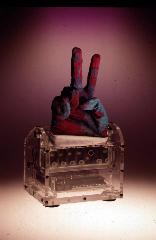|
| Home |
Technology Transfer |
 |
Ralph: A fingerspelling hand |
Investigators: David L. Jaffe, MS; Douglas F. Schwandt,
MS; and James H. Anderson, JEM
Summary: Ralph is a computer controlled electromechanical
hand that serves as a tactile display for persons who are deaf and blind. In
operation, the deafblind user feels the hand as it moves and interprets its
motions as letters corresponding to the American One-Hand Manual Alphabet, a
technique known as tactile fingerspelling. The hand is controlled by a
microcontroller whose software translates incoming serial ASCII data into
control signals that operate eight servo motors. These servo motors pull on the
fingers' mechanical linkages causing them to flex. Ralph can use information
from a computer's serial port, modem, TDD, or computer interface to a optical
character recognition scanner, voice recognition system, closed caption
decoder, or stenography machine facilitating translation of e-mail, telephone
conversations, printed text, spoken words, subtitled television programs, or
classroom/conference/courtroom interactions into fingerspelling.
Brief Project Description:
Ralph is a
computer-controlled electromechanical hand designed to be a receptive
communication aid for people who are deaf and blind. It offers these
individuals improved access to computers and communication devices in addition
to person-to-person conversations. Driven by microcomputer controlled servo
motors, this product also has potential for prosthetic, robotic, hand therapy,
and virtual reality applications.
Core Technology:
Ralph consists of two major
elements: its mechanical and computer systems. The fingers are made in three
segments, each mechanically linked to the next. A rod at the base of each
finger is driven by a servo motor to make the finger flex. The microcontroller
system generates and coordinates the servo control signals for all fingers.
Specific Technology Transfer Opportunities:
The
Rehab R&D Center is prepared to work with a company on the following
projects based upon the technologies developed for Ralph. Funding options
include those from SBIR proposals or Cooperative Research and Development
Agreement (CRADA). The company should have experience in one or more of the
following areas: microcontroller technology, servo motor control, mass
production techniques, and devices for people with disabilities. The Rehab
R&D Center will contribute its 8 years of fabrication, mechanical design,
and computer expertise toward a commercial prototype.
-
1. Fingerspelling hand: The Center is looking for a
company to bring the fingerspelling application to commercial availability.
-
2. Prosthetic hand: The mechanical system of Ralph
could form the basis of an improved prosthetic hand. The user would operate the
hand by emg signals picked up by surface electrodes on the skin.
-
3. Robotic end-effector: A three fingered mechanical
hand modeled after Ralph could be employed in a robotic manipulator. Each
finger could have multiple segments and sensors for feedback. The hand could be
remotely operated.
-
4. Hand therapy: A wearable version of Ralph would
allow people with arthritis to engage in range-of-motion exercises. Moving the
fingers of the good hand wearing a dataglove would cause movement of the
fingers of the other hand.
-
5. Virtual reality: A wearable version of Ralph would
permit the user to obtain force feedback during manipulation of virtual
objects. The finger positions of the user's hand could also be acquired.
For additional information contact
David L. Jaffe.

|
